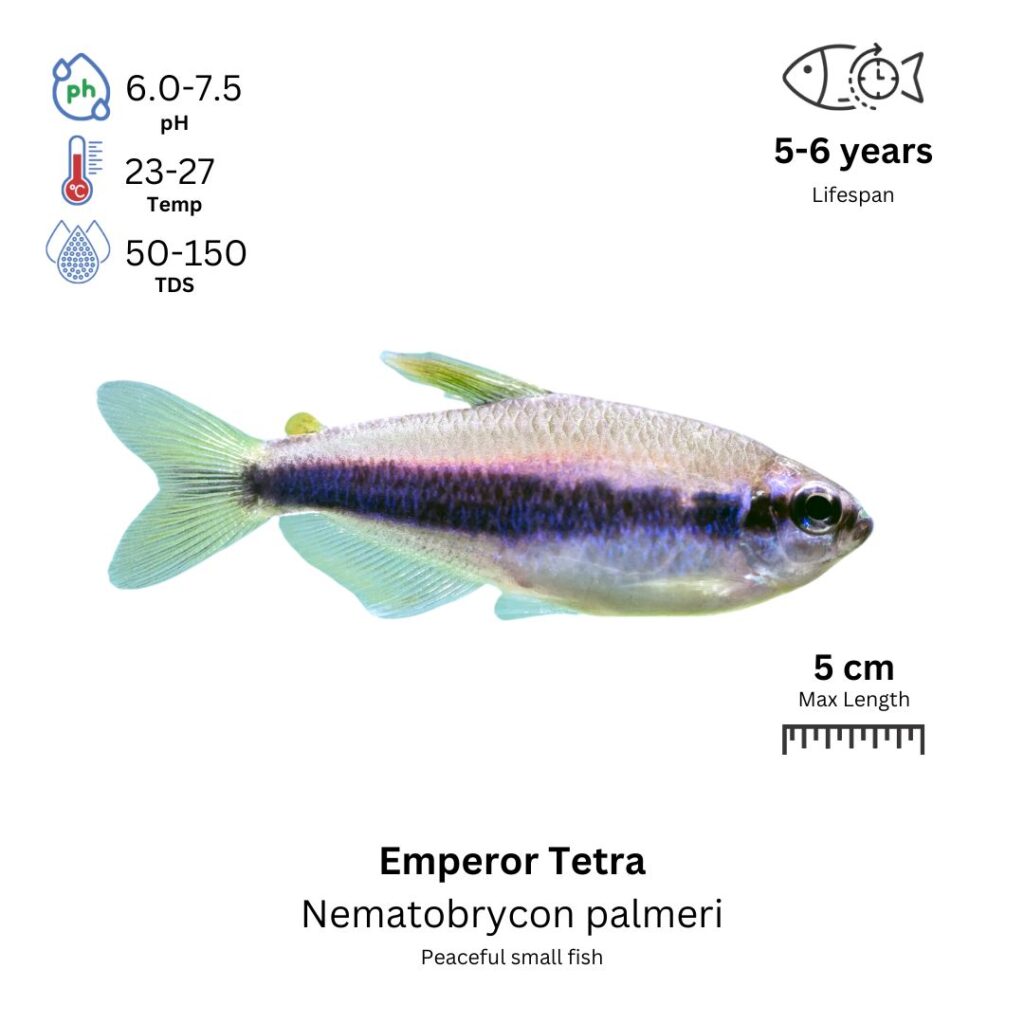Emperor Tetra
Nematobrycon palmeri

Description
The Emperor Tetra is a small, strikingly colorful fish known for its iridescent body that can range from a light blue to a rich greenish hue, with orange and red highlights along its fins and tail. The male has a vibrant coloration with more pronounced red and blue shades, while the female tends to have a more subdued appearance. They have a sleek, elongated body and long fins. Emperor Tetras are peaceful and active swimmers, often seen schooling in the middle to upper sections of the tank. Their calm nature and beautiful colors make them a popular choice for community aquariums.
Habitat Origin
Native to the slow-moving waters of the Orinoco and Casiquiare rivers in South America, particularly in Venezuela and Colombia, where they inhabit clear, acidic waters with dense vegetation.
Aquarium
Ideal Number in Aquarium: At least 6 individuals, as they are schooling fish and feel more secure in groups.
Favorite Food

Emperor Tetras are omnivores and will accept a variety of foods, including high-quality flake food, micro pellets, and live or frozen foods like brine shrimp, daphnia, and bloodworms. They also appreciate occasional plant matter, such as blanched spinach or algae wafers.
Behavior:
Emperor Tetras are peaceful and non-aggressive. They are schooling fish and do best in groups of at least 6, where they display their natural social behavior. They are active swimmers, often found in the middle and upper parts of the aquarium. Despite their small size, they are not shy and will confidently interact with their environment. They are also known for their playful nature, often darting around the tank in groups. They do well in community tanks with other peaceful species but may be intimidated by larger or more aggressive fish.
Special Care:
Emperor Tetras prefer a well-planted tank with plenty of hiding spots, such as rocks, driftwood, and live plants. They thrive in stable water conditions, so regular water changes and good filtration are important. These tetras also prefer slightly acidic water with low to moderate hardness, which mirrors their natural environment in South American rivers. It’s essential to maintain consistent water quality to avoid stress and disease.
Compatibility with Other Fish:
Yes, they are excellent for community tanks with other small, peaceful fish. Emperor Tetras get along well with species like other tetras, rasboras, small catfish, and shrimp. Avoid keeping them with aggressive or large species that might view them as food. They are also a good choice for aquascaped tanks due to their peaceful nature and striking appearance.
Breeding Tank Setup
Using a separate breeding tank is highly recommended for Emperor Tetras to maximize egg survival. In a community tank, eggs are easily eaten by adults or other fish. A 10-gallon tank (38 liters) is suitable for breeding a pair or small group, while a 20-gallon tank (75 liters) is ideal for multiple pairs. Maintain pH 5.5–7.0, temperature 24–28°C (75–82°F), and water hardness 2–12 dGH. Equip the tank with a gentle sponge filter for safe circulation. Include fine gravel or bare bottom, and live plants such as Java moss or Hornwort for egg-laying. Moderate lighting on a 12-hour cycle will help simulate natural conditions.
Conditioning
To prepare Emperor Tetras for breeding, offer a nutritious and varied diet: tropical flakes, live or frozen foods (like brine shrimp, daphnia, bloodworms), and vegetable-based options such as spinach or peas. Healthy nutrition boosts fertility and spawning success. Maintain excellent water quality through weekly 25–30% water changes. To stimulate breeding, perform a 50% water change and slightly increase the temperature to mimic natural spawning triggers like seasonal rainfall.
Spawning Behavior
Spawning usually takes place in the early morning, particularly after environmental triggers like a large water change. Males display vivid colors and chase females to initiate courtship. The female scatters 30–50 sticky eggs on plants or smooth surfaces, which the male fertilizes. Once spawning is complete, remove the adult fish immediately to prevent egg predation. A calm, undisturbed environment is essential for egg development.
Fry Hatching
Eggs will hatch within 24–36 hours, depending on water temperature. Fry become free-swimming after 3–4 days, at which point feeding should begin. Offer infusoria or liquid fry food initially, then gradually introduce baby brine shrimp, microworms, or finely crushed flakes as they grow. Keep water clean and safe with frequent, small water changes (10–20%), and avoid overfeeding to prevent water pollution. Maintain a stable temperature between 24–28°C to support fry development.
Breeding Age, Sexing, and Stress Avoidance
Emperor Tetras reach breeding age between 6–12 months. Males are more colorful and slender with brighter fins, while females are rounder—especially when gravid. Stress must be minimized to promote successful breeding: avoid sudden changes in water chemistry, temperature, or hardness, and ensure a calm environment without aggressive tank mates. Consistent care, gentle conditions, and close observation are the keys to breeding this elegant species successfully.
